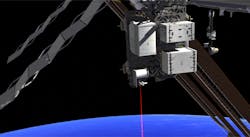SpaceX OPALS laser payload to beam video from the International Space Station
Although originally scheduled to blast off from a SpaceX rocket on April 14 as part of a third Commercial Resupply Services (CRS) launch for the International Space Station (ISS), the rocket will now launch on Friday, April 18 carrying with it the Optical Payload for Lasercomm Science (OPALS). The goal of the OPALS mission—developed and being implemented by a team of about 20 individuals from NASA's Jet Propulsion Laboratory (Pasadena, CA) through the lab's Phaeton early-career-hire program—is to complete NASA’s first optical communication experiment on the orbital ISS laboratory.
RELATED ARTICLE: Sophisticated optical systems extend reach of free-space communications
Scientific instruments used in space missions increasingly require higher communication rates to transmit gathered data back to Earth or to support high-data-rate applications, like high-definition video streams. Laser beams offer the promise of much higher data rates than what is achievable with current radio frequency (RF) transmissions and has the advantage of operating in a frequency band that is currently unregulated by the Federal Communications Commission.
"Optical communications has the potential to be a game-changer," said Mission Manager Matt Abrahamson. "Right now, many of our deep space missions communicate at 200 to 400 kilobits per second." OPALS will demonstrate up to 50 megabits per second, and future deep space optical communication systems will provide over one gigabits per second from Mars.
"It's like upgrading from dial-up to DSL," added the project's systems engineer Bogdan Oaida. "Our ability to generate data has greatly outpaced our ability to downlink it. Imagine trying to download a movie at home over dial-up. It's essentially the same problem in space, whether we're talking about low-Earth orbit or deep space."
OPALS is scheduled to launch aboard a SpaceX Falcon 9 rocket, part of a cargo resupply mission to the space station. The payload will be inside the Dragon cargo spacecraft. Once deployed, OPALS will be conducting transmission tests for a period of nearly three months, with the possibility of a longer mission. After the Dragon capsule docks with the station, OPALS will be robotically extracted from the trunk of the Dragon, and then manipulated by a robotic arm for positioning on the station's exterior. It is the first investigation developed at JPL to launch on SpaceX's Falcon rocket.
The technology demo was conceived, developed, built and tested at JPL by engineers in the early stage of their careers in order to gain experience building space hardware and developing an end-to-end communication system. The system uses primarily commercial off-the-shelf hardware and encloses electronics in a pressurized container. "We were not as constrained by mass, volume or power on this mission as we were by cost," said Abrahamson, and this approach allowed a lower cost development on an efficient schedule.
As the space station orbits Earth, a ground telescope tracks it and transmits a laser beacon to OPALS. While maintaining lock on the uplink beacon, the orbiting instrument's flight system will downlink a modulated laser beam with a formatted video. Each demonstration, or test, will last approximately 100 seconds as the station instrument and ground telescope maintain line of sight. It will be used to study pointing, acquisition and tracking of the very tightly focused laser beams, taking into account the movement of the space station, and to study the characteristics of optical links through Earth's atmosphere. NASA will also use OPALS to educate and train personnel in the operation of optical communication systems.
The success of OPALS will provide increased impetus for operational optical communications in NASA missions. The space station is a prime target for multi-gigabit-per-second optical links. Fast laser communications between Earth and spacecraft like the space station or NASA's Mars Curiosity rover would enhance their connection to engineers and scientists on the ground as well as to the public.
OPALS is a partnership between NASA's Jet Propulsion Laboratory in Pasadena, CA; the ISS Program based at Johnson Space Center in Houston; Kennedy Space Center in Florida; Marshall Space Flight Center in Huntsville, AL, and the Advanced Exploration Systems Division at NASA Headquarters in Washington.
SOURCE: NASA; http://www.jpl.nasa.gov/news/news.php?release=2014-111
About the Author

Gail Overton
Senior Editor (2004-2020)
Gail has more than 30 years of engineering, marketing, product management, and editorial experience in the photonics and optical communications industry. Before joining the staff at Laser Focus World in 2004, she held many product management and product marketing roles in the fiber-optics industry, most notably at Hughes (El Segundo, CA), GTE Labs (Waltham, MA), Corning (Corning, NY), Photon Kinetics (Beaverton, OR), and Newport Corporation (Irvine, CA). During her marketing career, Gail published articles in WDM Solutions and Sensors magazine and traveled internationally to conduct product and sales training. Gail received her BS degree in physics, with an emphasis in optics, from San Diego State University in San Diego, CA in May 1986.
